As 2020 draws to a close, Wine Lister has compiled a report celebrating the top-performing wines and producers within a series of categories over the past year. Using our axes of Quality, Brand, and Economics, and the several factors that constitute these values, we have created seven leagues that paint a panoramic view of some of the world’s best wines, ranked within their areas of excellence.
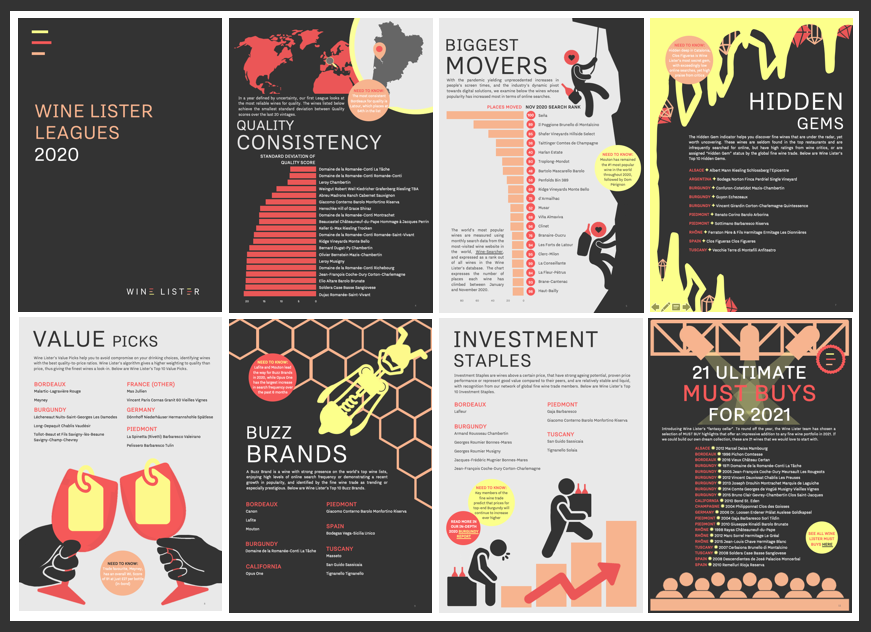
Wine Lister’s 2020 Leagues include rankings of Quality Consistency (wines that show the smallest standard deviation between Quality scores over the last 20 vintages), and Biggest Movers (wines whose popularity has increased most in terms of online searches over the past year). Our team has also put together its top-10 wines per Wine Lister Indicator, revealing our recommendations for Hidden Gems, Value Picks, Buzz Brands, and Investment Staples.
We end the Leagues with a list of 21 Ultimate MUST BUYs for 2021, compiling a selection of MUST BUY highlights hand-picked by our fine wine experts, that offer an impressive addition to any fine wine portfolio in 2021. These are some of the picks that would feature in Wine Lister’s “fantasy cellar”.
Download your free copy of Wine Lister’s 2020 Leagues here.
Releases from two cult Californian producers have taken centre stage this week so far – see the analysis below.
Vérité 2017s
The 2017 vintage of the Vérité trio – La Muse, Le Désir, and La Joie – was released on Monday, at £320 per bottle each (in-bond). The latest releases have picked up much praise from critics, and mark an historic year for the estate – completing its harvest one week before the arrival of North California’s devastating Tubbs Fire, Vérité’s vineyards escaped unscathed, and their grapes picked before any smoke taint from neighbouring areas could set in. This also marks the first collective release of Vérité’s flagship wines in an assorted case, with previous vintages available to purchase separately.
Comprising 100% Merlot grapes for the first time since its conception, La Muse 2017 receives 96 points from Wine Lister partner critic, Antonio Galloni. He notes that the vintage “is aromatically deep, beautifully persistent and just impeccable in its balance”, stating that he “liked it more than the 2016”. A price of £320 places the 2017 20% below the current market price of the 2016, which has risen over 30% in price since its release, and has limited remaining market availability.
Le Désir 2017 obtains 98 points from Galloni – its highest ever score from the critic. He states it is “off the charts fabulous”, and describes notes of “mocha, chocolate, licorice, leather, menthol, pine and spice”. Akin to La Muse, market availability of last year’s release is scarce, illustrating its good track record of selling through post-release. Keeping in mind the 2017’s record-breaking score, it will be interesting to see if this trend continues this year, given the collective format in which the wines are being sold.
La Joie 2017 breaks the same record as its sibling, Le Désir, receiving its highest score to date from Galloni (96). He calls it “another gorgeous wine in this lineup”, describing “hints of rose petal, lavender, mint and blood orange”, and concluding that it is “a stunning wine by any measure”.
Joseph Phelps
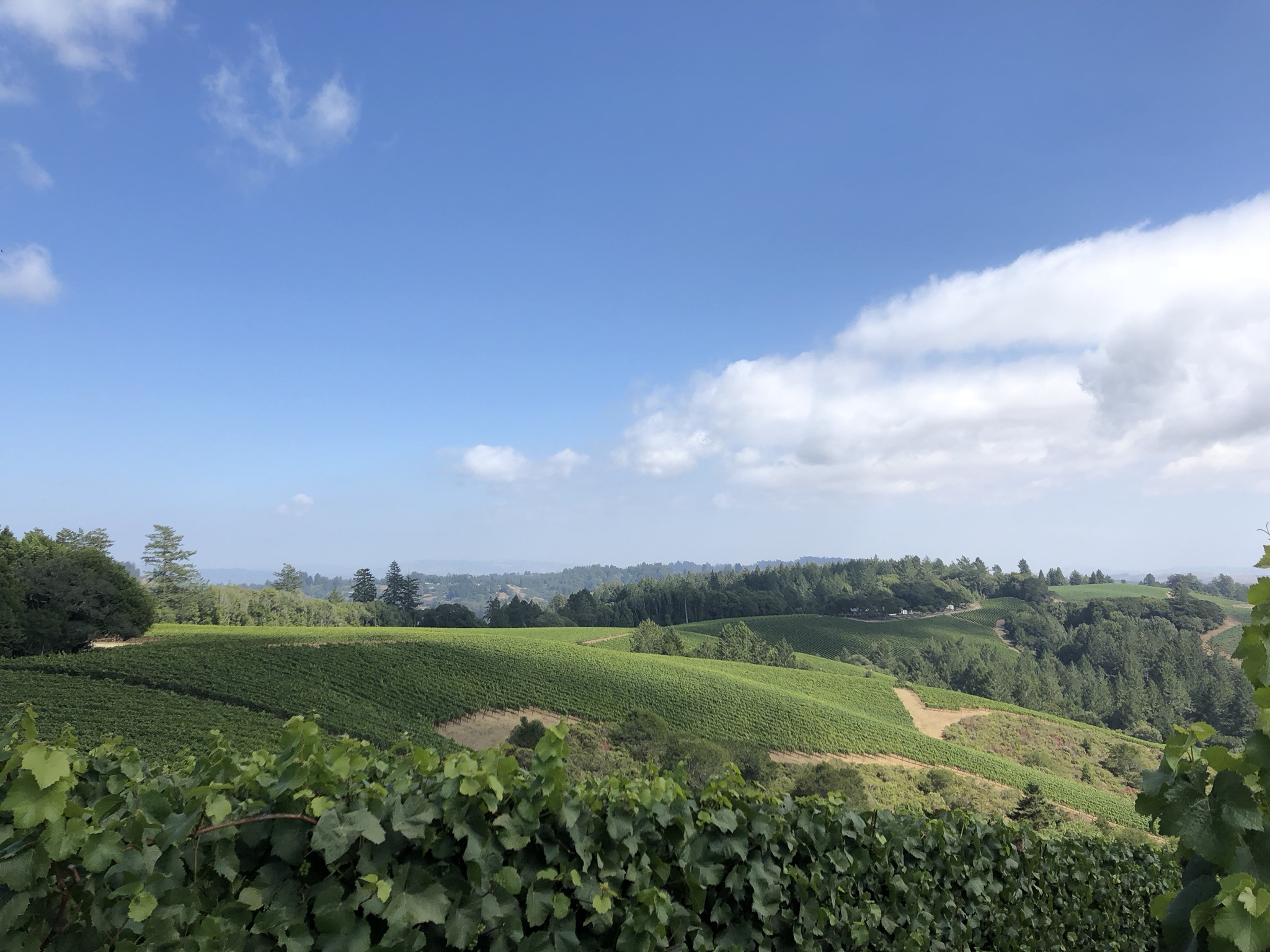 Joseph Phelps’ Napa Valley vineyards – which saw their hottest recorded temperatures in 2017
Joseph Phelps’ Napa Valley vineyards – which saw their hottest recorded temperatures in 2017
Insignia 2017 entered the market yesterday at £160 per bottle in-bond (flat on the 2016 release price). As we were told in a recent Zoom tasting with Phelps’ granddaughter and the winery’s Director of Business Development, Elizabeth Neuman, the 2017 vintage lives up to her vision of Insignia as “a tangible legacy of Joe himself – achieving the best of the best”. Neuman informed us of Winemaker, Ashley Hepworth’s recent dedication to achieving texture in the wine, through which she has experimented with blending trials prior to ageing.
Awarding Insignia 2017 91-94 points, Galloni indeed describes a “dark, sumptuous and enveloping feel, with a real sense of breadth and textural resonance”, adding that “more than anything else, the 2017 is all about palate richness”. Wine Lister likewise recognised the finessed texture of the vintage, with Wine Lister CEO, Ella Lister, calling it “supple, gentle, and silky” on the palate, complete with “dark fruit, plum, and chocolate” on the nose.
Frequent heatwaves in 2017 saw record-high temperatures reached throughout the growing season, including an instance of 46.7°C, recorded in Phelps’ Saint Helena Ranch during Labor Day weekend. The 2017 vintage is consequentially the winery’s smallest in 20 years, with total production down 60% on the 2016. The significant reduction in the volume released this year, as well as the estate’s developing style, may work to encourage interest.
Also released over the past two days: Orma 2018, Petrolo Galatrona 2018, and Siepi 2018.
Sign up to Wine Lister’s free subscription to get market insights delivered straight to your inbox: https://wine-lister.com/subscribe/info.
As en primeur 2018 picks up pace, we consider the 10 Bordeaux wines that any fine wine collector should acquire for their collection. These are based on the results of Wine Lister’s latest Founding Member survey, gathering the views of over 50 key players in the global fine wine trade.
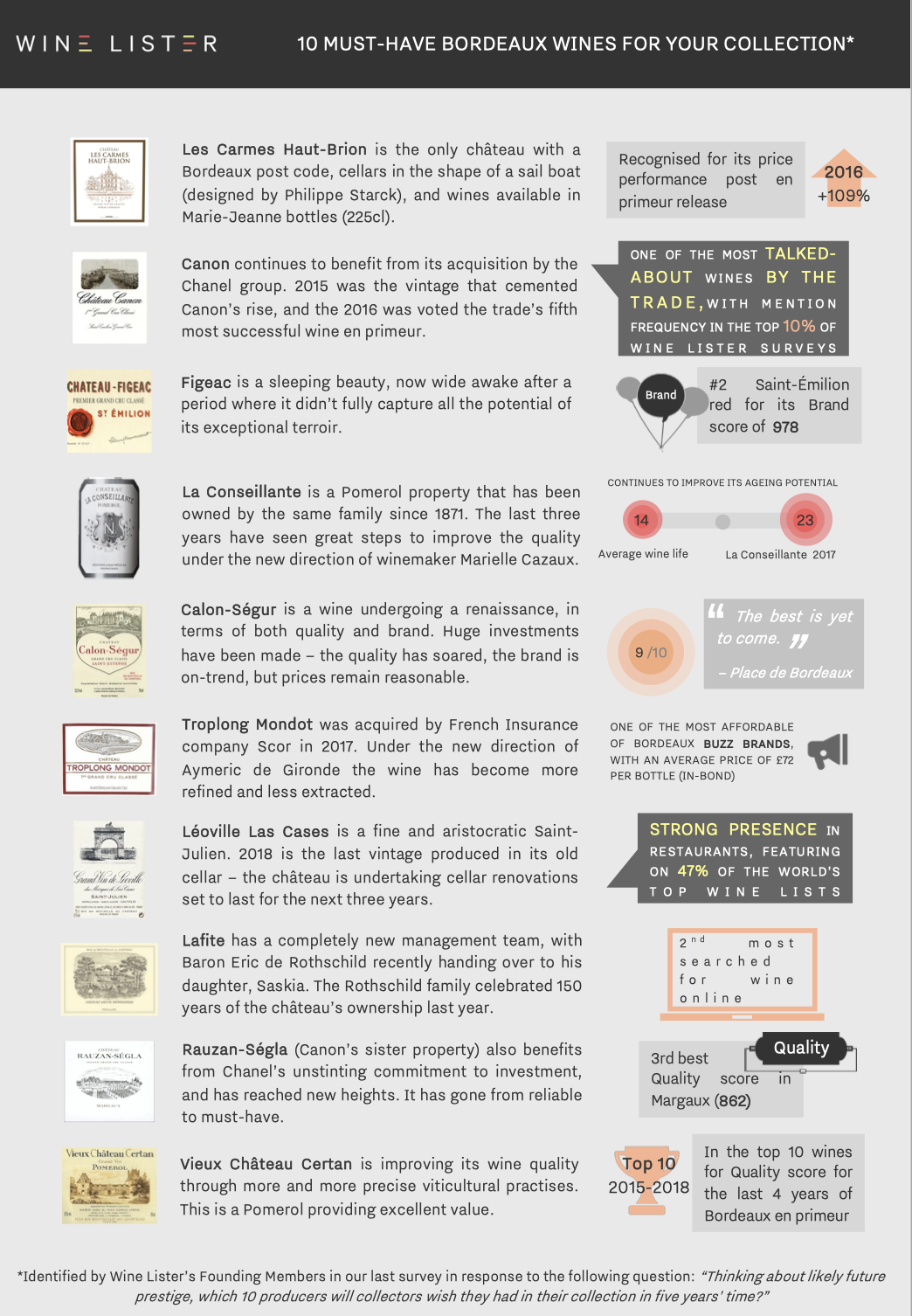
You can download this slide here: 10 must have Bordeaux wines for your collection
In Bordeaux, 2018 was a winemakers’ vintage. That much is clear from conversations the Wine Lister team had throughout en primeur tasting week, explained further in Bordeaux 2018 en primeur part I : the vintage. Though quality across the board was good in 2018, the greats stand out all the more for being the result of key technical decisions, rather than just terroir.
Below we look at the top 25 Bordeaux 2018 red Quality scores, based on the recently-released ratings of Wine Lister partner critics Bettane+Desseauve, Julia Harding for Jancis Robinson, Antonio Galloni for Vinous, and Jeannie Cho Lee. The average Quality score of these top 25 is 975, 25 points higher than the equivalent top red panel in 2017.
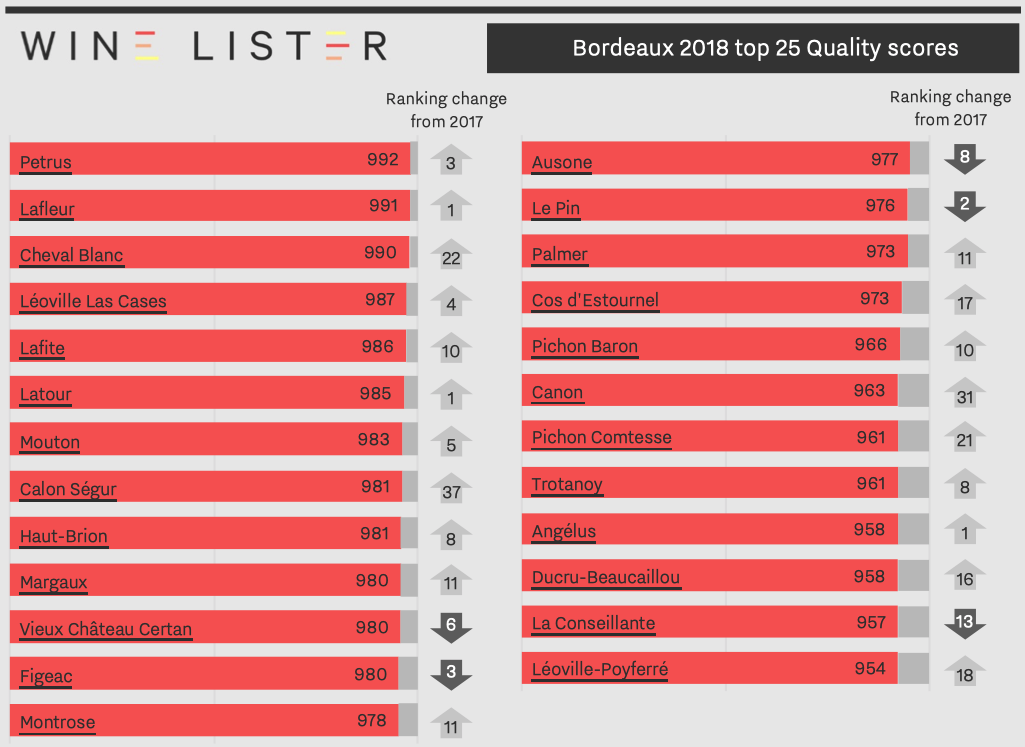
Right bank super-appellation, Pomerol earns the highest number of places in the top 25 red Quality scores (6), and includes the first- and second-best wines of the vintage, Petrus and Lafleur. They earn Quality scores of 992 and 991 respectively, and the former is awarded 97-100 points by Wine Lister partner critic, Antonio Galloni, who comments, “From the very first taste, the 2018 Petrus is simply magical”.
Proving the potential for high quality across both banks in Bordeaux 2018, the next highest appellations are Pauillac and Saint-Émilion with 5 wines appearing in the top 25 apiece. Pauillac wins out overall, with an average score of 976 (vs. 974 in Saint-Émilion). Cheval Blanc (990) and Canon (963) show impressive Quality improvements on 2017, moving 22 and 31 places up the rankings respectively.
Pauillac’s top quality wines are made up, perhaps unsurprisingly, of the three Pauillacais first growths, Lafite (986), Latour (985), and Mouton (983), and super-seconds Pichon Baron and Pichon Comtesse. This last is holds the appellation’s most-improved ranking, moving up 21 places from its 2017 position. Julia Harding of JancisRobinson.com writes of Pichon Comtesse 2018, “A gentle and surprisingly subtle beauty”.
Elsewhere on the left bank, Saint-Julien and Saint-Estèphe earn three wines each in the top 25 for Quality. The best of these, Léoville Las Cases, earns a Quality score of 987. The three Saint-Estèphe wines follow consecutively, with front-runner and rising star Calon-Ségur moving up 37 places from its 2017 ranking – the largest improvement of all the top 25 Quality scorers in 2018.
Margaux and Pessac-Léognan appear just thrice between them in the top 25 for Quality, with Margaux (980), tiny-production Palmer (973), and Haut-Brion (981).
Other wines featuring in the top 25 Bordeaux 2018 Quality scores are: Figeac, Vieux Château Certan, Montrose, Ausone, Le Pin, Cos d’Estournel, Ducru-Beaucaillou, Léoville-Poyferré, Angélus, Trotanoy, and La Conseillante.
This week’s “top five” blog is a first for Wine Lister, as we analyse the highest-Quality wines of a single producer, Michel Chapoutier. Readers should note that this is simply an analysis exercise, and not a paid advertisement (albeit a shining review of Chapoutier, given how high the Quality scores are).
In first place of this week’s top five, perhaps surprisingly, is a white wine – Chapoutier’s Ermitage Blanc L’Ermite, with a Quality score of 966. Not only does this make it the highest-quality white Rhône on Wine Lister, but also the second highest-quality wine from the Northern Rhône overall, beaten only by Jean-Louis Chave’s Hermitage Cuvée Cathelin. The 2015 earns 94-96 points from Wine Lister partner critic, Vinous, with Josh Raynolds commenting on its “outstanding focus and persistence”. While outperforming its siblings for Quality, it also earns the highest average price of the group, at over £300 per bottle in-bond.
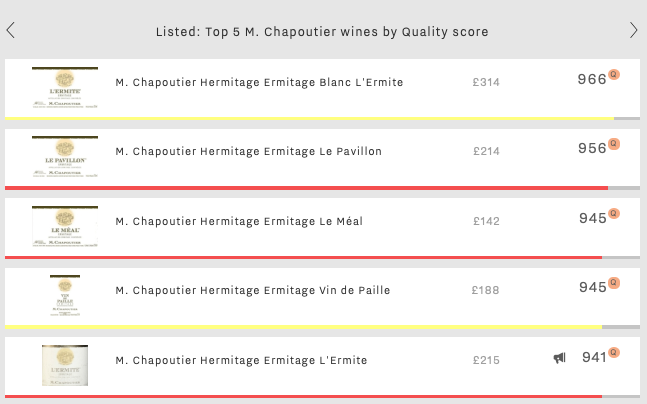
Next up is the first red of the group, Ermitage Le Pavillon, with a Quality score of 956. Wine Lister partner critic, Jancis Robinson, awards the 2016 vintage an impressive 19 points, naming it a “polished and pure Hermitage”. It also earns the group’s best Brand score of 897, appearing in 15% of the world’s best restaurants and ranking in 266th place for Wine-Searcher searches among the c.4,000+ wines on Wine Lister.
In joint-third place comes the second red of the group, Ermitage Le Méal, and Chapoutier’s sweet white, Ermitage Vin de Paille. Both achieve a Quality score of 945, however they are distinctive not just in their respective styles, but also in their Brand scores. Le Méal is clearly the better-known, with a Brand score of 724 and a search rank of 710, compared with the Vin de Paille’s Brand score of 593 (the lowest of this week’s top five), and a search rank of 2088. Interestingly however, the Vin de Paille’s presence in the world’s top restaurants is the better, if only by 1% (6% vs. 5% for Ermitage Le Méal).
Rounding out Chapoutier’s top five for Quality is the Ermitage L’Ermite, with a Quality score of 941. Despite its position at the bottom of the group, it achieves the highest Quality score at vintage level for the 2010 (992). The Ermitage L’Ermite 2010 achieves 95+ points from Wine Lister partner critic, Vinous, and though Josh Raynolds calls it “remarkably long, chewy, smoke- and spice-accented…”, he also warns it “should be stashed away and forgotten for a good long while”.
Wine Lister recently analysed the Bordeaux 2009 vintage in two parts. The first – a tasting and subsequent selection of top picks by Wine Lister’s founder, Ella Lister, revealed sublime quality across both banks. The second – a two-page analysis of the vintage overall – reveals that alongside top quality, prices of Bordeaux 2009s are high, and it is therefore all the more difficult to find good value, particularly among the left bank’s classified growths.
With this in mind, our Listed: top five blog this week explores the highest-quality Bordeaux fifth growths from the 2009 vintage. Despite the great quality across appellations, all five hail from Pauillac. They are all also Wine Lister Buzz Brands.
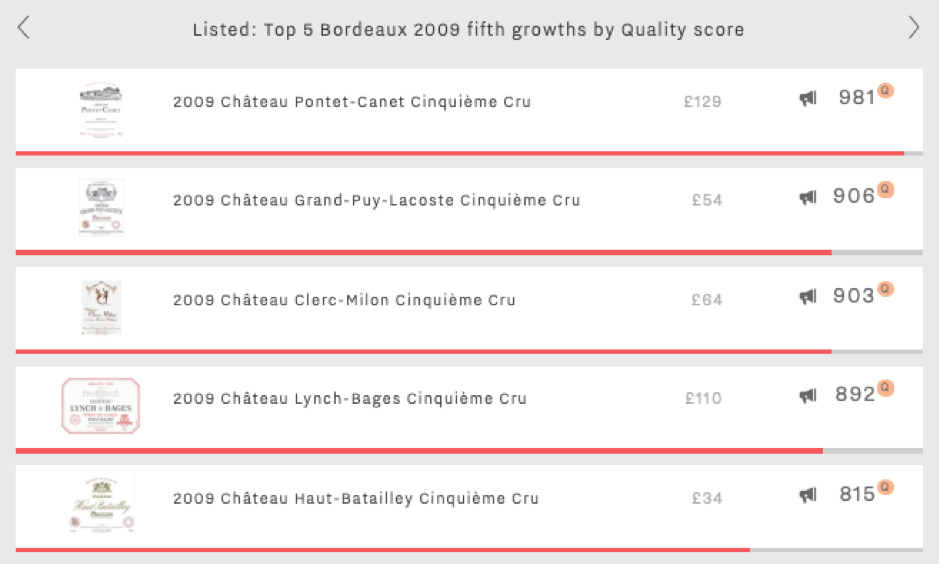
In first place is Pontet-Canet 2009. Its Quality score of 981 sits a full 102 points above the average of the other four wines in this week’s top five. This presumably contributes to its price of £129 per bottle in-bond – the highest of the group.
Next is Grand-Puy-Lacoste 2009, with a Quality score of 906 and the second-lowest price of this week’s top five (£54 per bottle in-bond). It is the only one of the group to appear among top picks from the recent 2009 re-tasting.
Just three points behind Grand-Puy-Lacoste, in third place, is Clerc-Milon 2009. In the economics department it outperforms the rest of the group significantly, with an Economics score of 905 and a compound annual growth rate (CAGR) of 17.3% – over two and a half times higher than the average of the other four wines in this week’s top five.
This week’s last two wines now fall under the same ownership, that of the Cazes Family. Nonetheless, the 2009 vintages of Lynch-Bages and Haut-Batailley, which achieve Quality scores of 892 and 815 respectively, present quite different profiles. Lynch-Bages is this week’s “brand king” with a Brand score of 996 – the highest of this week’s top five – and a price of £110 per bottle in-bond. Though Haut-Batailley 2009 achieves a Quality score 7% lower than Lynch-Bages, its price of £34 is 69% lower than that of its sibling, therefore providing exceptional value. After the acquisition and subsequent repositioning of Haut-Batailley through its 2017 en primeur release, it will be interesting to see how both châteaux fare in the upcoming 2018 campaign.
Yesterday marked the annual BI Fine Wines’ 10 years on tasting, this year focusing on the iconic Bordeaux 2009s. Below we explore what light Wine Lister data has to shed on the 2009 vintage including quality, price performance, and best wines for good value.
Wine Lister’s holistic and dynamic approach allows us to not only see which appellations produced the vintage’s best wines, but also demonstrates if and how the market has since reacted to their relative quality.
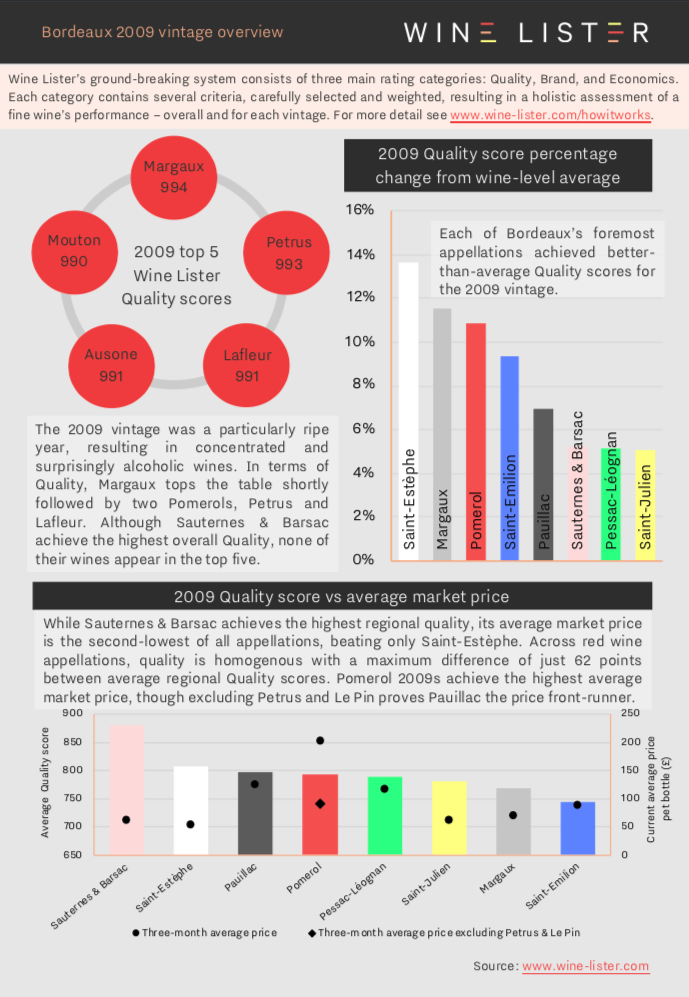

You can download the slides here: Wine Lister Bordeaux 2009 vintage overview
Featured wines: Margaux, Petrus, Lafleur, Ausone, Mouton, Capbern, Lilian Ladouys, Couhins-Lurton, Fourcas Hosten, Guillot Clauzel, Clos Saint-Martin, Lynsolence, La Cabanne, and Pavillon Rouge.
One of the major trends identified in Wine Lister’s first Champagne study was the rise of grower Champagnes. While maison offerings dominate the top 20 highest-quality Champagnes from the basket of 108 studied, growers achieve a higher average Quality score overall (862 vs. 853). This week’s top five looks at the top Champagnes under £100 by Quality score, and helps us examine the grower vs. maison phenomenon further.
The first of this week’s top five is grower Champagne Egly-Ouriet’s Vieillissement Prolongé Extra Brut with a Quality score of 919. Though top of the leader board for Quality, it is the least expensive of this week’s group at an in-bond per bottle price of £55 (or 34% less than the average price of the other four Champagnes). This is perhaps due to it being the only non-vintage Champagne of the group, and provides testament to the great price to quality ratio of N.V. Champagnes across the board.
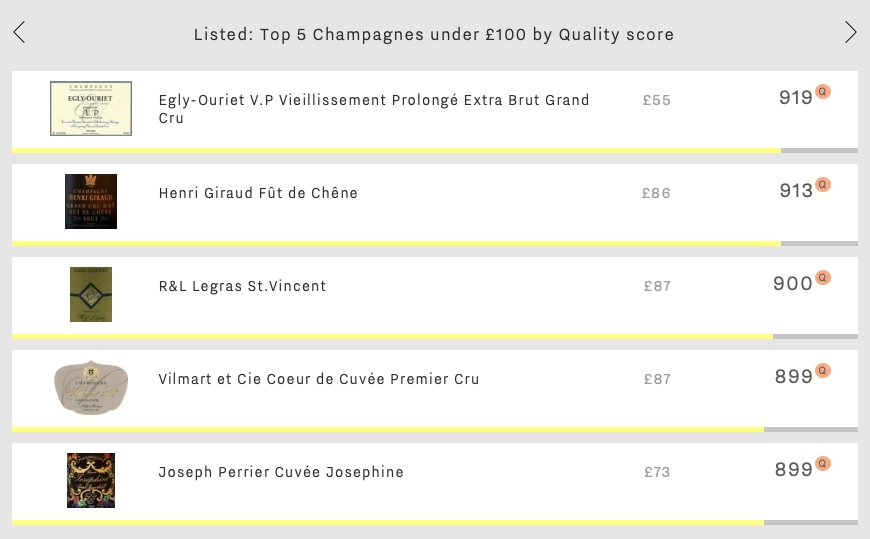
Next up of this week’s top five is Henri Giraud’s Fût de Chene with a Quality score of 913. For the purposes of Wine Lister’s Champagne study, Henri Giraud was in fact not classed as a grower Champagne, since our definition of ‘grower’ signified properties who use 100% of their own grapes (Henri Giraud buys in 20%). The 1999 vintage earns 18 points from Wine Lister partner critic Jancis Robinson, who calls it “a sort of Montrachet of Champagne”.
Third of this week’s top five is R&L Legras’ St. Vincent. Earning a Quality score of 900, it is the only Blanc de Blancs of the group. In true grower fashion, this little-known Champagne ranks as the 1,985th most-searched-for wine of the c.4,000+ wines on Wine Lister and is present in just 3% of the world’s best restaurants.
The last two Champagnes of this week’s top five may have the same Quality score of 899, but have very different profiles. It is surely a satisfying conclusion that, despite maison Champagne’s stronger brand position overall, these two wines (one maison and one grower) prove the opposite to be true. Maison offering Joseph Perrier’s Cuvée Josephine has the lowest Brand score (474) of this week’s top five, while grower Champagne Vilmart et Cie Coeur de Cuvée earns the highest (779), with a search rank in 854th place and presence in 11% of the world’s best restaurants. The rise of grower Champagnes is in full force.
For a more in-depth look at Champagne, subscribe or log-into read the full report here. Alternatively, all readers can access a five-page executive summary. (Both versions are also available to download in French).
To many a wine expert, Riesling is amongst the world’s finest white wine grape varieties, perhaps thanks to its versatile nature. The aromatic grape does well as both a sweet and dry wine, to drink straight away or suitable for long-term ageing. This week Wine Lister looks at the top five Rieslings under £100 by Quality score, which all hail from Alsace or the Mosel.
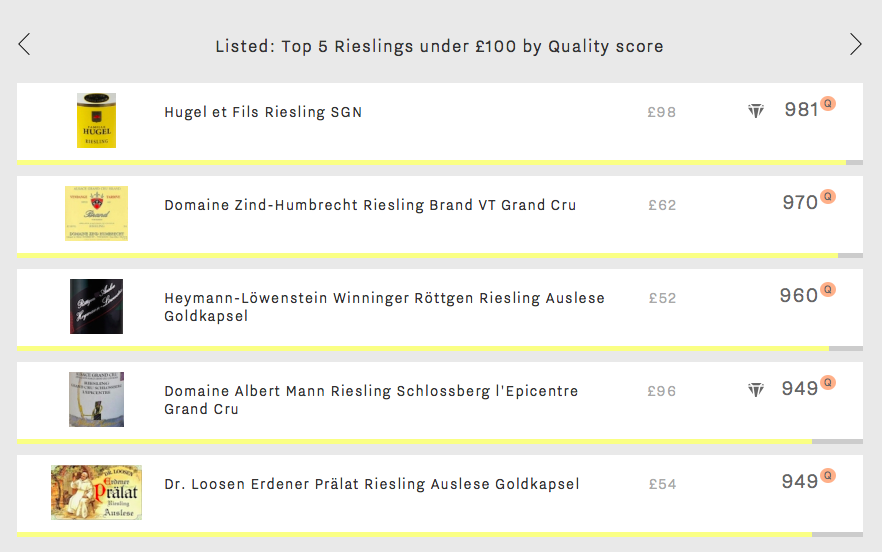
Hugel et Fils’ Riesling SGN takes the top spot this week with a Quality score of 981. This phenomenal Quality score is in part the result of an average wine life of 24 years (compared to 13 years for the rest of this week’s top five). The Riesling SGN from Hugel is therefore perhaps justifiably this week’s most expensive choice, at an average price of £98 per bottle in-bond. Sadly, it might take a Christmas miracle to source this in time for next week’s festivities. An average of just 600 bottles are produced of this Wine Lister Hidden Gem each year.
Next is Domaine Zind-Humbrecht’s Riesling Brand VT with a Quality score of 970. Though in second place for Quality, it achieves this week’s best Economics score of 633 (and also this week’s best overall Wine Lister score) – despite only 18 bottles of it having been traded at auction in the last year. It is the short-term price performance that really boosts the Economics score – the price having increased by 17% in the last six months.
In third place is this week’s first German wine – Heymann-Löwenstein’s Winninger Röttgen Riesling Auslese Goldkapsel. It achieves a Quality score of 960, and at only £52 per bottle in-bond it is this week’s most affordable option.
The two remaining spots of this week’s top five share the same Quality score (949). Domaine Albert Mann Schlossberg l’Epicentre Grand Cru is this week’s second Hidden Gem. Its Hidden Gem status is confirmed by a modest Brand score of 255 – the lowest of the group, due to presence in just 1% of the world’s top restaurants, and being only the 3,797 most-searched-for of Wine Lister’s wines on Wine-Searcher.
Rounding off the group is the second Riesling from Germany, Dr. Loosen Erdener Prälat Auslese Goldkapsel. If you are looking for Quality look no further than its 2006 vintage, which achieves a Quality score of 975 at an average price of £44 per bottle in-bond (compared to the wine’s overall average price of £54 in-bond). Its excellent quality-to-price ratio earns it a spot as one of Wine Lister’s Value Picks – indeed, it is given high praise from Wine Lister partner critic, Antonio Galloni, claiming it to be a “…massive and yet somehow delicate auslese of stunning quality”.
It’s the most wonderful (if most expensive) time of the year. Wine Lister Value Picks help you to avoid compromise on your seasonal drinking choices, identifying wines and vintages with the best quality-to-price ratios. This week’s top five looks at some affordable options for you – still with impressive Quality scores – complete with two Ports in the mix to keep us feeling festive. With Italy and Portugal sharing the top five (and even the top 10) red Value Picks by Quality score, Wine Lister’s Christmas drinking picks stick firmly to Mediterranean climes.
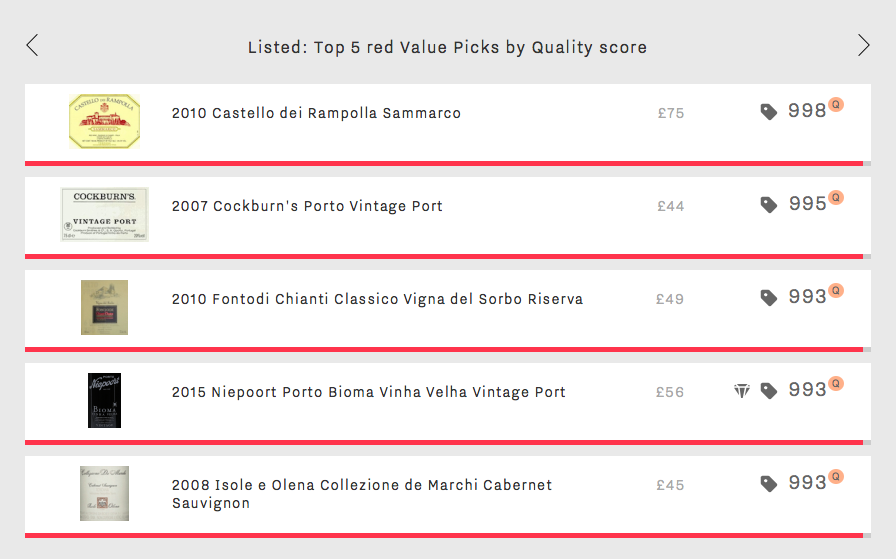
In first place is Castello dei Rampolla Sammarco 2010. Although it is this week’s most expensive option (at £75 per bottle in-bond* vs. an average £49 of the four other wines of this top five) the spectacular Quality score of 998 is impossible to ignore. Indeed, it earns the highest Quality score of any 2010 red on Wine Lister, alongside three others – Castello dei Rampolla’s Alceo, Cerbaiona Brunello di Montalcino, and Vietti Barolo Ravera – all of which are at least £71 more expensive. Sammarco 2010’s remarkable Quality score is due a perfect score of 100/100 from Vinous’ Antonio Galloni, who describes it as “stunning” and “magnificent”.
Next is this week’s first port – Cockburn’s Vintage Port 2007. With a Quality score of 995 and price of £44 there can be no doubt about its status as a Value Pick. It has just entered its drinking window, and with a predicted wine life of 53 years, it could make for the perfect Christmas gift (if you can refrain from drinking it yourself).
The group’s second port, Niepoort Bioma Vinha Velha Vintage Port 2015, shares a Quality score of 993 with the last three spots of this week’s top five. It is the only one of this week’s Value Picks also to achieve Hidden Gem status – Wine Lister’s Indicator for excellent wines that are yet to receive proper recognition. Although it will not be ready to drink until 2028, at £56 per bottle this is an exceptional value wine to store away for Christmases to come.
Rounding out this week’s top five in Tuscan triumph are Fontodi’s Chianti Classico Vigna del Sorbo 2010 and Isole e Olena’s Collezione de Marchi Cabernet Sauvignon 2008. They have both just entered their drinking windows, but will last for many years to come. Each earning a Quality score of 993, their modest prices of £49 and £44 per bottle respectively provide fantastic value.
All that remains is to wish you a very Merry Christmas.
*Prices shown assume the purchase of a whole case. See more on pricing on our website.










